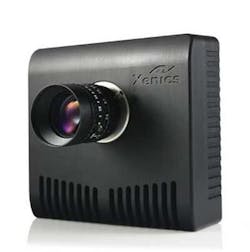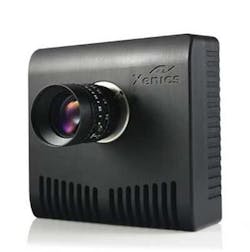IMAGE CAPTURE: High-speed IR camera meets biomedical demands
To measure the effects of how a particular drug may perform, molecular scientists often use infrared (IR) spectroscopy techniques. Since specific molecules or groups of molecules rotate or vibrate at specific frequencies, these frequencies can be used to determine the specific bonds between molecules and their strengths. By transmitting IR energy through a particular sample and measuring how much light was absorbed at any given wavelength, the molecular structure of the sample is revealed.
“Measuring the effects of how a specific drug may recombine with other molecules,” says Johan Blommaert of Xenics (Leuven, Belgium; www.xenics.com), “requires IR cameras that are fast since molecular recombination may occur in the order of milliseconds.” To address such applications, Xenics has recently released what the company claims to be the world’s fastest InGaAs camera, the Cheetah-640CL (see figure).
Running at 1730 frames/s, the Cheetah-640CL IR camera operates in a 0.9–1.7-μm spectral band and uses two Base Camera Link interfaces with which to transfer data to a high-speed recording system at more than 6.33 Gbits/s.
With a frame rate of 1730 frames/s, the imager features a 640 × 512-pixel, 12-bit array with 20-μm pixels. To attain the 1730-frames/s data rate of the camera, the Xenics imager uses a multiple tap design with a total data throughput rate greater than 6.33 Gbits/s. Like other developers of high-speed cameras, Xenics faced problems when deciding which camera interface to use for the camera.
“Although a single Full Camera Link camera interface with 85-MHz transceivers on a frame grabber can be used with the camera when it is run in 8-bit mode,” says Blommaert, “a dual Medium Camera Link interface is required when the camera is operated in 12-bit mode.”
To capture data into the PC, Xenics initially used the Karbon-CL frame grabber from BitFlow (Woburn, MA, USA; www.bitflow.com), which can be used to simultaneously acquire data from one Full Camera Link camera in 8-bit mode. To capture 12-bit image data, Xenics turned to IO Industries (IOI; London, ON, Canada; www.ioindustries.com), interfacing the Cheetah-640CL to two of IOI’s DVR Express CLSAS video recorders.
Although the CLSAS is a PCI-X interface card, it does not use the host PC bus with which to transfer data. Instead, the two Camera Link ports from the camera are interfaced separately to each board and data from each board is then streamed to disk drives.
To control image-acquisition functions from the camera, Xenics also incorporated IOI’s Streams 5 video recording software. Using this software, developers can simultaneously record image data from both Camera Link inputs while synchronizing the data using the PC’s clock. After this data is recorded, image data can be viewed as single frames or thumbnail sequences.
While the price of the camera system alone is approximately €90,000 (approximately US$127,620), the cost of a complete PC-based system will, of course, be higher.
Like other high-speed sensor and camera developments from Aptina Imaging (San Jose, CA, USA; www.aptina.com) and Awaiba (Madeira, Portugal; www.awaiba.com), the cost of the cameras, the lack of an elegant very high speed camera-to-PC interface, and the difficulty in processing large amounts of data at high speed presently encumber the wide adoption of this technology.

